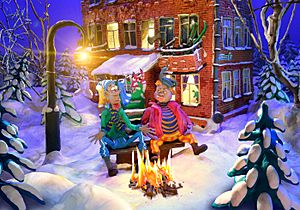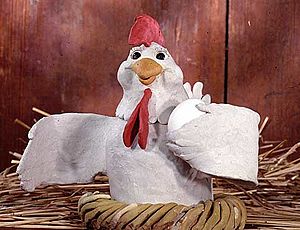Clay animation facts for kids
Clay animation, also known as claymation, is a cool way to make movies! It's a type of stop motion animation where everything you see – the characters, the backgrounds, even tiny props – is made from a soft, bendy material, usually plasticine clay.
Think of it like this: regular movies record movement as it happens. But with clay animation, you take a picture, then slightly move the clay model, then take another picture, and so on. When you play all those pictures really fast, it looks like the clay models are moving on their own! People started making clay-animated films in the United States as early as 1908.
Contents
How Clay Animation is Made
To make clay animation, artists first sculpt characters or objects out of clay. Often, they build a wire frame inside the clay, called an armature. This armature acts like a skeleton, helping the clay model keep its shape and allowing the animator to move it precisely.
Once the clay model is ready, it's placed on a set. The animator takes one photo. Then, they carefully move the model just a tiny bit, and take another photo. They repeat this process over and over. When all the photos are played quickly, your brain sees them as smooth motion. It's like a flipbook, but with clay!
Making a Clay Animation Movie
Making a stop-motion movie with clay takes a lot of hard work and patience. Imagine this: to make a 30-minute film, animators might need to take about 21,600 individual pictures! For a full-length movie that's 90 minutes long, that could mean taking 64,800 pictures or even more. Each picture requires the animator to carefully move the clay figures.
Animators often use a special term called a "hot set." This means the set where they are filming is very important and no one should touch it. If someone accidentally bumps the set or a character, it could ruin the scene because the models might shift. Also, things like humidity can affect the clay, making it change shape slightly. To avoid these problems, animators often try to finish filming a scene in one day.
Different Kinds of Clay Animation
Clay animation can be done in a few different ways:
- Freeform Clay Animation: This is when the clay models change their shape a lot as the animation goes on. It's very creative and can lead to some wild transformations!
- Clay Painting: This technique is a mix of stop motion and traditional flat animation. Imagine spreading clay on a flat surface, like a canvas. The animator then moves the clay around, almost like painting with wet oil paints. This creates images that look like clay but are flat.
- Clay Melting: This is a unique and informal type of clay animation. An animator might use a heat source to slowly melt the clay. A camera then films this melting process over time. When played back, it looks like the clay is magically melting and changing shape.
Famous Clay Animation Examples
Many popular movies and TV shows have used clay animation. Here are some examples you might know:
What is "Claymation"?
The word "Claymation" is a special name that is a registered trademark in the United States. It was registered by an animator named Will Vinton in 1978. He used this word to describe his own clay animation films.
Images for kids
See also
 In Spanish: Plastimación para niños
In Spanish: Plastimación para niños




